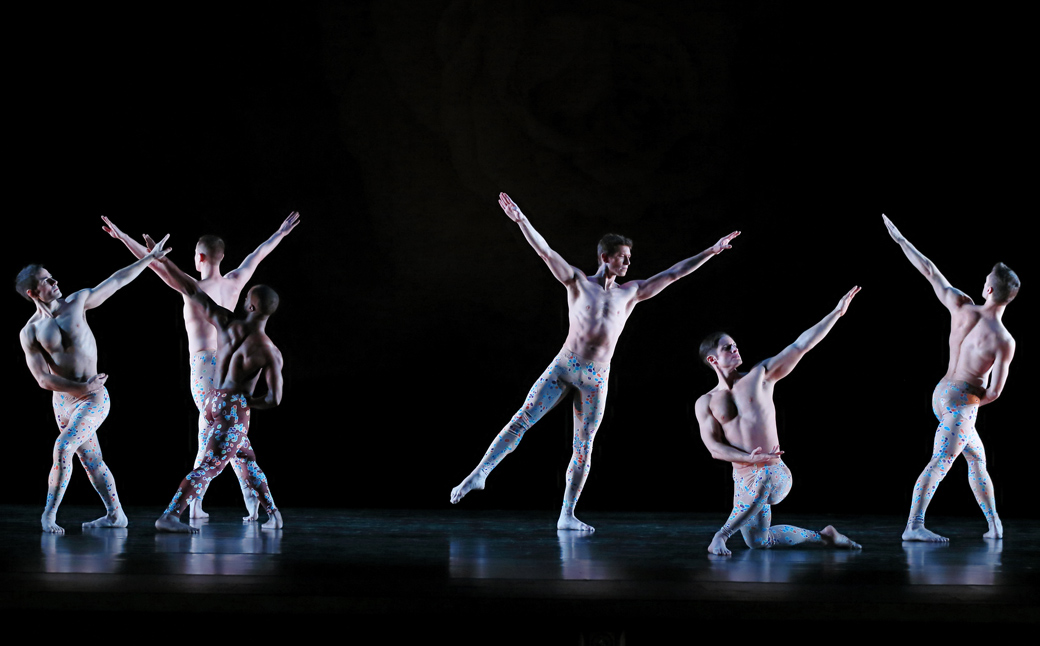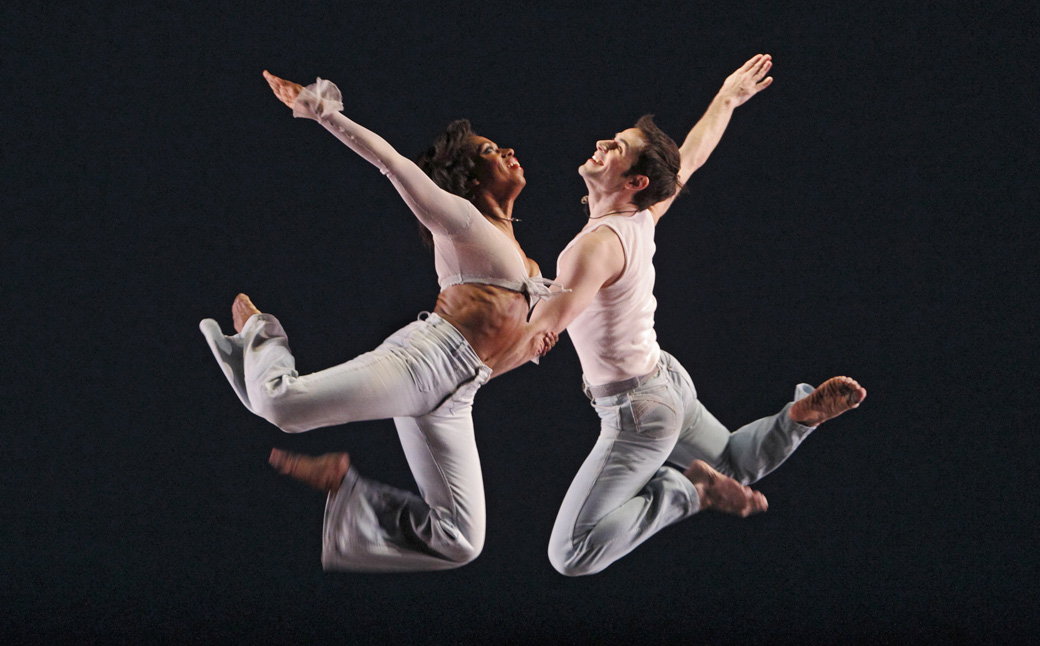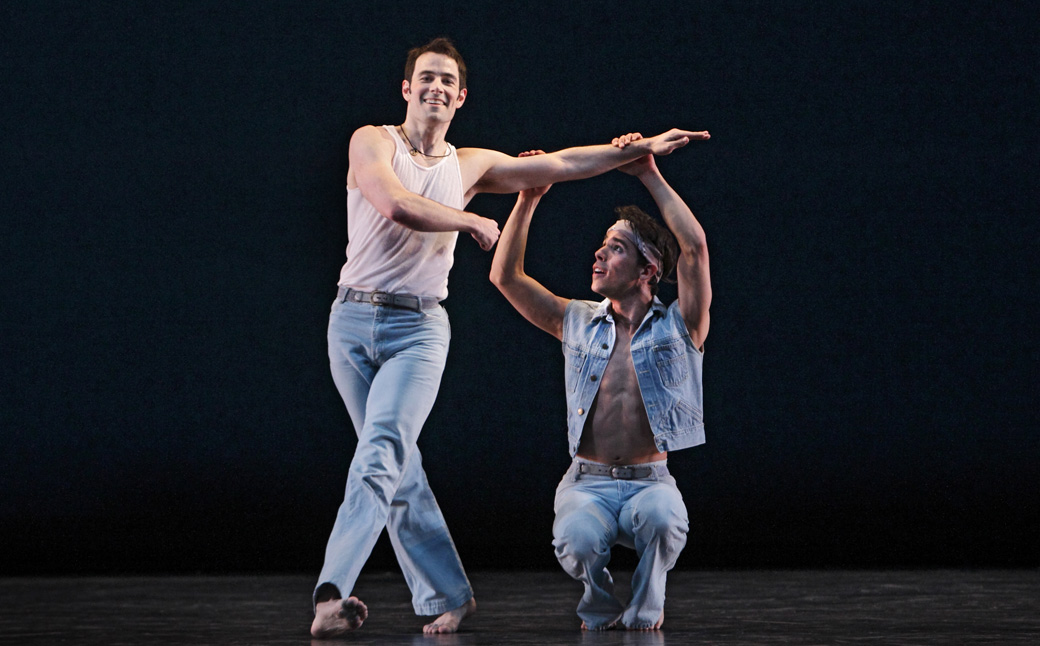Event Archives
Paul Taylor Dance Company
February 19, 2021
Livestream Event
PLA Presents
Our 20/21 season digital performances take place live on our stage. So, due to the winter storm, this livestream has been postponed until Friday, February 19 at 7 PM. Access for those who purchased will automatically be moved to the new date with on-demand availability through February 21.
“One of the most intelligent, stylish and physically magnificent dance troupes,” (New York Magazine) the Paul Taylor Dance Company beautifully carries on the dance icon’s legacy in this intimate program. Set to William Boyce's sumptuous baroque score, Arden Court is a sentimental masterpiece exploring love and relationships, while the Philadelphia premiere of A Field of Grass offers an ode to the 1960s with exuberant technique and wicked humor. Danced by a cast of eight, get ready to be captivated by “one of the most singular and searching imaginations of our time.” (The New York Times)
Access Information:
- Purchase access now through 7:30 PM on February 19.
- Watch live at 7 PM on February 19 to participate in the chat and Q&A with Michael Novak, the company's Artistic Director. Available on-demand through February 21.
This is an original, live event performed on our stage and streamed online. Visit our FAQs page for additional details.
Performances
- Friday, February 19 @ 7 PM
SUBSCRIBE AND SAVE
Artist Information
- Paul Taylor Dance Company Bio
- Paul Taylor Dance Company
“The American spirit soars whenever Taylor’s dancers dance.” – San Francisco Chronicle
Dance maker Paul Taylor first presented his choreography with five other dancers in Manhattan on May 30, 1954. That modest performance marked the beginning of 64 years of unrivaled creativity, and in the decades that followed, Taylor became a cultural icon and one of American history's most celebrated artists, hailed as part of the pantheon that created American modern dance.
The Paul Taylor Dance Company has traveled the globe many times over, bringing Taylor’s ever-burgeoning repertoire to theatres and venues of every size and description in cultural capitals, on college campuses and in rural communities, often to places modern dance had never been seen before. The Taylor Company has performed in more than 500 cities in 64 countries, representing the United States at arts festivals in more than 40 countries, and touring extensively under the aegis of the U.S. Department of State. In 1997, the Company toured throughout India in celebration of that nation's 50th anniversary. Its 1999 engagement in Chile was named the Best International Dance Event of 1999 by the country's Art Critics' Circle. In the summer of 2001, the Company toured in the People's Republic of China and performed in six cities, four of which had never seen American modern dance before and has since returned on four separate multi-week tours. In the spring of 2003, the Company mounted an award-winning, four-week, seven-city tour of the United Kingdom. The Company regularly tours throughout North America, South America, Asia and Europe.
While continuing to garner international acclaim, the Paul Taylor Dance Company performs more than half of each touring season in cities throughout the U.S. In celebration of the Company’s 50th anniversary and 50 years of creativity, the Taylor Foundation presented Taylor's works in all 50 states between March of 2004 and November of 2005. That tour underscored the Taylor Company's historic role as one of the early touring companies of American modern dance.
Beginning with its first television appearance for the Dance in America series in 1978, the Paul Taylor Dance Company has appeared on PBS in ten different programs including the 1992 Emmy® Award-winning Speaking in Tongues and the 1997 Emmy®-nominated The Wrecker's Ball (including Company B, Funny Papers and A Field of Grass). In 1999, the PBS American Masters series aired Dancemaker, the Academy® Award-nominated documentary about Taylor and his Company. In 2013, PBS aired Paul Taylor Dance Company in Paris which featured Brandenburgs and Beloved Renegade. The 2014 documentary Paul Taylor Creative Domain won critical and public acclaim for its revelation of Taylor’s creative process, following the famously private choreographer and his Company through the entire process of creating a new work from initial concept to opening night.
- Paul Taylor Bio
- Paul Taylor (Founding Artistic Director)
Paul Taylor, one of the most accomplished artists this nation has ever produced, helped shape and define America’s homegrown art of modern dance from the earliest days of his career as a choreographer in 1954 until his death in 2018. Having performed with Martha Graham’s company for several years, Taylor uniquely bridged the legendary founders of modern dance (Isadora Duncan, Ruth St. Denis, Ted Shawn, Doris Humphrey and Graham) and the dance makers of the 21st Century with whom he later worked. Through his initiative at Lincoln Center which began in 2015 (Paul Taylor American Modern Dance), he presented great modern works of the past and outstanding works by today’s leading choreographers alongside his own vast repertoire. He also commissioned the next generation of dance makers to work with his renowned Company, thereby helping to ensure the future of the art form.
Taylor continued to win public and critical acclaim for the vibrancy, relevance and power of his dances into his eighties, offering cogent observations on life’s complexities while tackling some of society’s thorniest issues. While he often propelled his dancers through space for the sheer beauty of it, he more frequently used them to comment on such profound issues as war, piety, spirituality, sexuality, morality and mortality. If, as George Balanchine said, there are no mothers-in-law in ballet, there certainly are dysfunctional families, disillusioned idealists, imperfect religious leaders, angels and insects in Taylor’s dances. His repertoire of 147 works covers a breathtaking range of topics, but recurring themes include the natural world and man’s place within it; love and sexuality in all gender combinations; and iconic moments in American history. His poignant looks at soldiers, those who send them into battle and those they leave behind, prompted The New York Times to hail him as “among the great war poets” – high praise indeed for an artist in a wordless medium. While some of his dances have been termed “dark” and others “light,” the majority of his works are dualistic, mixing elements of both extremes. While his work was largely iconoclastic, he also made some of the most purely romantic, most astonishingly athletic and downright funniest dances ever put onstage.
Taylor was born on July 29, 1930, exactly nine months after the stock market crash that led into the Great Depression, and grew up in and around Washington, D.C. He attended Syracuse University on a swimming scholarship in the late 1940s until he discovered dance through books at the University library. He then transferred to The Juilliard School. In 1954, he assembled a small company of dancers and began to choreograph. A commanding performer despite his late start in dance, he joined the Martha Graham Dance Company in 1955 for the first of seven seasons as soloist while continuing to choreograph on his own troupe. In 1959, he was invited to be a guest artist with New York City Ballet, where Balanchine created the Episodes solo for him.
Taylor first gained notoriety as a dance maker in 1957 with Seven New Dances. Its study in non-movement famously earned it a blank newspaper review, and Graham subsequently dubbed him the “naughty boy” of dance. In 1962, with his first major success, the sunny Aureole, he set his trailblazing modern movement not to contemporary music but to baroque works composed two centuries earlier, and then went to the opposite extreme a year later with a view of purgatory in Scudorama, using a commissioned, modern score. He inflamed the establishment in 1965 by lampooning some of America’s most treasured icons in From Sea To Shining Sea, and created more controversy in 1970 by putting incest and spousal abuse center stage in Big Bertha.
After retiring as a performer in 1974, Taylor turned exclusively to choreography, resulting in a flood of masterful creativity. The exuberant Esplanade (1975), one of several Taylor dances set to music by Bach, was dubbed an instant classic, and has come to be regarded as among the greatest dances ever made. In Cloven Kingdom (1976), Taylor examined the primitive nature that lurks just below man’s veneer of sophistication and gentility. With Arden Court(1981), he depicted relationships both platonic and romantic. He looked at intimacy among men at war in Sunset (1983); pictured Armageddon in Last Look (1985); and peered unflinchingly at religious hypocrisy and marital rape in Speaking In Tongues (1988). In Company B (1991), he used popular songs of the 1940s to juxtapose the high spirits of a nation emerging from the Depression with the sacrifices Americans made during World War II. In Eventide (1997), he portrayed the budding and fading of a romance. In The Word (1998), he railed against religious zealotry and blind conformity to authority. In the first decade of the new millennium, he poked fun at feminism in Dream Girls (2002); condemned American imperialism in Banquet of Vultures (2005); and stared death square in the face in the Walt Whitman-inspired Beloved Renegade (2008). Brief Encounters (2009) examined the inability of many people in contemporary society to form meaningful and lasting relationships. In this decade, he turned a frightening short story into a searing drama in To Make Crops Grow and compared the mating rituals of the insect world to that of humans in the comedic Gossamer Gallants. Taylor’s final work, Concertiana, made when he was 87, premiered at Lincoln Center in 2018.
Hailed for uncommon musicality and catholic taste, Taylor set movement to music so memorably that for many people it is impossible to hear certain orchestral works and popular songs and not think of his dances. He set works to an eclectic mix that includes Medieval masses, Renaissance dances, baroque concertos, classical warhorses and scores by Debussy, Cage, Feldman, Ligeti and Pärt; Ragtime, Tango, Tin Pan Alley and Barbershop Quartets; Harry Nilsson, The Mamas and The Papas and Burl Ives; telephone time announcements, loon calls and laughter. Taylor influenced dozens of men and women who have gone on to choreograph (many on their own troupes) while others have gone on to become respected teachers at colleges and universities. And he worked closely with outstanding artists such as James F. Ingalls, Jasper Johns, Alex Katz, Ellsworth Kelly, William Ivey Long, Santo Loquasto, Gene Moore, Tharon Musser, Robert Rauschenberg, John Rawlings, Thomas Skelton and Jennifer Tipton. Taylor’s dances are performed by the Paul Taylor Dance Company, the six-member Taylor 2 Dance Company (begun in 1993) and companies throughout the world including the Royal Danish Ballet, Rambert Dance Company, American Ballet Theatre, San Francisco Ballet, Miami City Ballet and Alvin Ailey American Dance Theater.
As the subject of the documentary films Dancemaker and Creative Domain, and author of the autobiography Private Domain and the Wall Street Journal essay Why I Make Dances, Taylor shed light on the mysteries of the creative process as few artists have. Dancemaker, which received an Academy® Award nomination in 1999, was hailed by TIME as “perhaps the best dance documentary ever.” Private Domain, originally published by Alfred A. Knopf, was nominated by the National Book Critics Circle as the most distinguished biography of 1987. A collection of Taylor’s essays, Facts and Fancies, was published by Delphinium in 2013.
Taylor received nearly every important honor given to artists in the United States. In 1992, he was a recipient of the Kennedy Center Honors and received an Emmy® Award for Speaking in Tongues, produced by WNET/New York the previous year. He was awarded the National Medal of Arts by President Clinton in 1993. In 1995, he received the Algur H. Meadows Award for Excellence in the Arts and was named one of 50 prominent Americans honored in recognition of their outstanding achievement by the Library of Congress’ Office of Scholarly Programs. He is the recipient of three Guggenheim Fellowships as well as honorary Doctor of Fine Arts degrees from California Institute of the Arts, Connecticut College, Duke University, The Juilliard School, Skidmore College, SUNY Purchase, Syracuse University and Adelphi University. Awards for lifetime achievement include a MacArthur Foundation Fellowship (often called the “genius award”) and the Samuel H. Scripps American Dance Festival Award. Other awards include the New York State Governor's Arts Award and the New York City Mayor's Award of Honor for Art and Culture. In 1989, Taylor was elected one of 10 honorary members of the American Academy and Institute of Arts and Letters. Having been elected to knighthood by the French government as Chevalier de l'Ordre des Arts et des Lettres in 1969 and elevated to Officier in 1984 and Commandeur in 1990, Taylor was awarded France’s highest honor in 2000, the Légion d’Honneur, for exceptional contributions to French culture.
Taylor died in Manhattan on August 29, 2018, leaving an extraordinary legacy of creativity and vision not only to American modern dance but to the performing arts the world over.
- Michael Novak Bio
- Michael Novak (Artistic Director)
Michael Novak became only the second Artistic Director in the history of the Paul Taylor Dance Foundation in September of 2018, upon the death of Founding Artistic Director Paul Taylor the previous month. Novak was a member of the Paul Taylor Dance Company from 2010-2019.
Raised in Rolling Meadows, IL, Novak began studying dance at age 10. At 12, he developed a severe speech impediment that required intensive therapy. Dance became a liberating and vital force for self-expression. “I wanted nothing more than to achieve in dancing that sense of effortlessness and grace that were so difficult for me to find while speaking aloud,” he said. “With dancing, there were no limits to what I could express.” In 2001, Novak was offered a Presidential Scholarship to attend The University of the Arts in Philadelphia to pursue training in jazz and ballet. The following year, he undertook an apprenticeship at the Pennsylvania Academy of Ballet Society, where he remained until 2004.
Novak was admitted to Columbia University’s School of General Studies where he was awarded scholarships for academic excellence. He became a member of the Columbia Ballet Collaborative, the University’s critically acclaimed resident company, and was named Artistic Associate responsible for advising on the curation of resident choreographers and directing the group’s branding and promotion. At Columbia, Novak became immersed in the study of dance history, which ignited his passionate devotion to modern dance. He developed a keen interest in the work of François Delsarte, the 19th-century French movement theorist who codified the system linking emotion and gesture that would inspire the first generation of American modern dancers. A highlight of his studies at Columbia was performing Paul Taylor’s solo in Aureole, which led him to embrace the Taylor repertoire. In 2008, Novak graduated magna cum laude from Columbia and was elected to Phi Beta Kappa.
In a 2009 program celebrating Serge Diaghilev at Columbia’s Miller Theatre, Novak embodied Vaslav Nijinsky’s role in L’Après-midi d’un faune with an authenticity that brought him to the attention of dance critics and scholars. He has since performed works by Bill T. Jones and Stephen Petronio, and danced with Gibney Dance and the Daniel Gwirtzman Dance Company. He has also studied at Springboard Danse Montréal under Alexandra Wells and Coleman Lemieux & Compagnie (now Citadel + Compagnie).
Novak’s Paul Taylor Dance Company debut in the 2010-11 season earned him a nomination for the Clive Barnes Foundation Dance Award. During his nine-year career, he danced 57 roles in 50 Taylor dances, 13 of which were made on him, and created roles for five of the Taylor Company Commission choreographers. In announcing Novak’s appointment as Artistic Director Designate in March of 2018, Taylor said, “Michael has mastered our repertory and steeped himself in dance history. He understands the need to nurture the past, present and future of modern dance. I look forward to working with him and preparing him to assume artistic leadership of my Company.”
“I am determined to further Paul Taylor’s vision,” Novak said upon assuming the role of Artistic Director, “and to bring his gems to every part of the globe… to honor past dance makers and encourage future artists… and to make sure modern dance remains a transformative force for good in our lives long into the future.”
Program Notes [PDF]
Photo credit: Paul B. Goode




